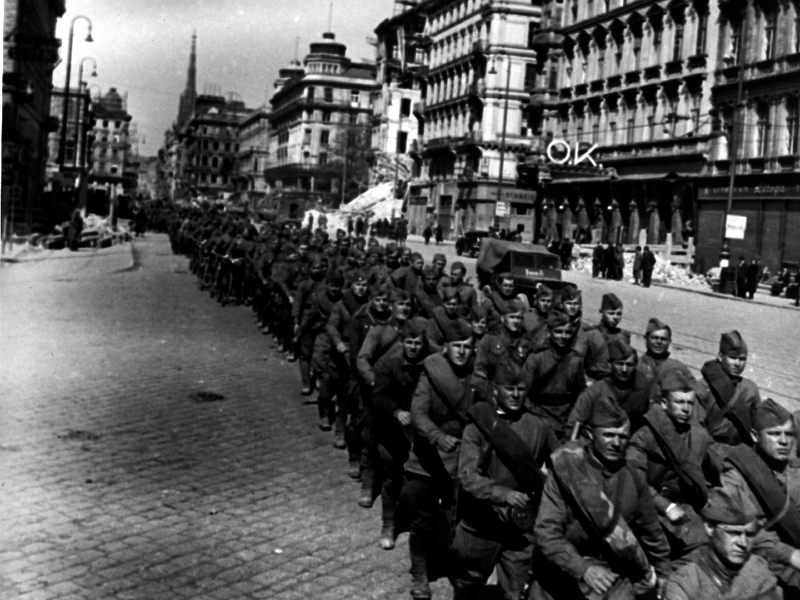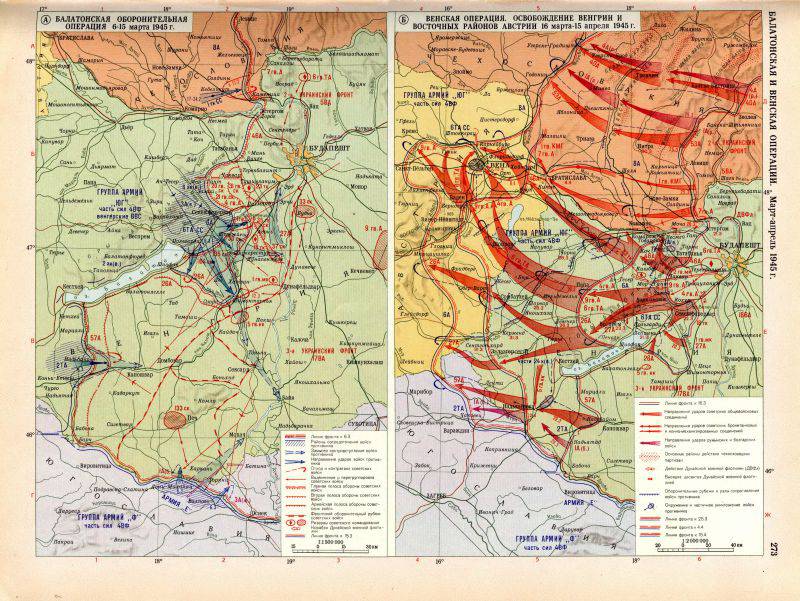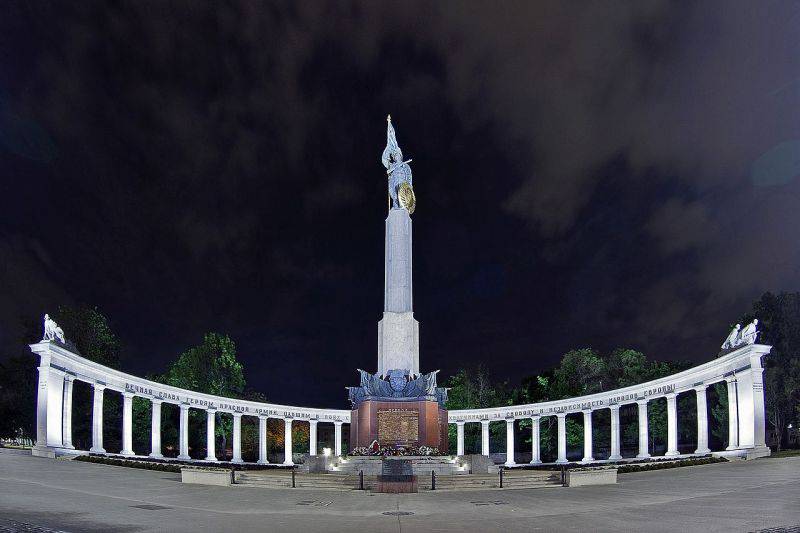One of the most brilliant operations of the 1945 campaign of the year is the Vienna operation.

16 March 1945, the Vienna Offensive began. In the course of this operation, the troops of the 2 and 3 of the Ukrainian fronts, with the assistance of the 1 of the Bulgarian army, completed the liberation of Hungary, and liberated the eastern parts of Austria with its capital, Vienna. The Third Reich lost the last oil region in Western Hungary - Nagykanizsa and a large industrial center - the Vienna industrial region. Wehrmacht suffered another heavy defeat.
The Vienna offensive operation, which lasted until mid-April, is somehow obscured by the more famous battles of the Great Patriotic War - the battle for East Prussia with the assault on Koenigsberg, the Balaton operation and the assault on Berlin. However, this battle was of great importance. Its scope is evidenced by the number of troops that were involved in the operation on both sides: more than 1 million 150 thousand people, about 18 thousand guns and mortars, more than 2 thousand tanks and self-propelled guns, about 1700 aircraft.
The situation before the battle
Three days after the assault on Budapest (The bloody finale of the Budapest group), 17 February 1945, Supreme Commander Joseph Stalin ordered the 2 and 3 Ukrainian fronts to conduct an offensive operation with the aim of defeating Army Group South and seizing the area of Bratislava - Brno - Vienna - Nagykanizsa. The offensive was scheduled for March 15. 1945. The liquidation of the huge Budapest garrison became an important prerequisite for the attack on Vienna.
However, before the Soviet fronts organized a new strategic operation, the Wehrmacht launched its last offensive in the area of Lake Balaton (The failure of the last major offensive of the Wehrmacht). 6 March The 6-I tank SS army, the 6-I field army and the 2-I tank army launched an offensive north and south of Lake Balaton. The German command planned to send Soviet troops into the Danube, restoring the front line on this great European river, thereby eliminating the threat to the oil fields of Hungary, Austria and the southern regions of Germany. During the fierce battle, select armored formations of the Third Reich were defeated, losing most of the tanks and assault guns to play a negative role in the defense capability of the Berlin region. Hitler simply did not have large armored formations for the defense of Berlin.
At the same time, reflecting the stubborn attacks of the enemy, the Ukrainian fronts continued preparations for an offensive on the Vienna direction. The offensive began immediately after the Balaton defensive operation, without an operational pause. This was due to the fact that the German divisions suffered heavy losses, having lost a significant part of their combat capability, which changed the overall balance of forces in favor of the Red Army. In addition, the Soviet fronts remained large reserves.
The time was convenient for the offensive. Germany was on the verge of defeat. The measures by which the German military-political leadership tried to keep the Eastern Front, more and more bear the stamp of despair, confusion and disorder. The human and military material capabilities of the Third Reich were almost exhausted. The reserves were created with great difficulty and more and more often were spent in the “fire order”. German, Hungarian soldiers and officers for the most part began to understand that the war was finally lost. This became especially clear after the failure of the counteroffensive in the Lake Balaton area. They were confused, the combat effectiveness of the troops fell. Senior officers were increasingly dismissed for the fact that they could not solve the impossible task - to stop the Red Army. So one of Hitler’s most powerful generals, Frisner, was removed from his post as commander of Army Group South, Wöhler took his place. The closest associates of the Fuhrer - Himmler, Goering and others, strenuously probed the situation in the ruling circles of Britain and the USA. However, even with all the will of the part of the Anglo-Saxon elite, to preserve the remnants of the military power of the Third Reich and make Germany the cutting edge of the “crusade” against the Red Empire, time was already lost. The Soviet army was advancing too fast and violated all the plans of the American and British ruling circles, who hoped to prevent the Russians from entering Central Europe.
Operation plan
Due to the changing situation during the Balaton battle, the 9 headquarters in March 1945 set new tasks for the two Ukrainian fronts. Now the main blow was to be delivered not by the 2-th Ukrainian Front, but by the 3-th Ukrainian. Immediately after the Balaton operation was completed, the right wing of the 3 of the Ukrainian Front (4 and 9 of the Guards armies, 6 of the Guards Tank Army) was to go on the offensive and defeat the 6 of the SS Tank Army in the Sekeshfehervar region.
The 9 Guards Army of Glagolev inflicted a main attack on Veszprem and, in cooperation with the 4 Guards Army of Zahvatayev and the 26 Army, Gagena was to surround and destroy the main forces of the German tank army south and south-west of Szekesfehervar. 4-I Zakhvatiev Guards Army received the task to bypass Székesfehérvár on both sides, to take the city, turned by the Germans into a major stronghold, by the end of the second day of the offensive to reach the line of the Sharviz channel, not allowing the enemy to withdraw to the north-west. Located in the second echelon of the main shock grouping of the front, the 6-I Kravchenko Guards Tank Army was to launch the 19 offensive in March and complete the defeat of the main forces of the SS 6-Tank Army.
Three armies of the front shock group struck at the 31 km section in the Gantt zone to Lake Velence. It was possible to create a fairly large density of artillery. However, the tank of direct support for infantry was not enough. So in the area south of Zama on 1 km of the front there were 170-180 guns and mortars and only 12 tanks and SPG. At the same time, the powerful German 4 SS Panzer Corps defended here. The troops of the front on the main line had a fourfold advantage in manpower and ninefold in artillery. True, the lack of ammunition did not allow the use of artillery in full force. Ammunition stocks from previous battles have not yet been restored. For example, the troops of the 3 of the Ukrainian Front had a total 1-1,5 ammunition kit, and there was also a shortage of food and fuel. For tanks was approximate equality.
Further, the main forces of the two guards armies were to develop an offensive in the direction of Papa-Sopron-Vienna. Part of the forces of the front attack force had to clear the area of Szombathely and Zalaegerszeg from the enemy, contributing to the defeat of the enemy's Nadkanizha group.
The troops of the center (26-I and 27-I armies) and the left wing of the front (57-I army and 1-I Bulgarian army) were to start the offensive later. 26-I and 27-I armies were given the task of defeating enemy troops in the areas of Polgardi, Tyurje, Szombathely, Zalaegerszeg and then to advance in southern Austria (Carinthia). The 57-I and 1-I Bulgarian armies were advancing south of Lake Balaton and were to occupy an oil-bearing region with the center in the town of Nagykanizsa.
The strike group of the 3rd Ukrainian Front dealt an auxiliary strike and was to go on the offensive on March 17-18. The 46th Army conducted the Gyor operation. The main blow was inflicted on a site north of Chakvar, and after the capture of the city of Gyor, the 46th Army was given the task of developing an offensive in the Vienna direction, facilitating the actions of the main strike group of the 2nd Ukrainian Front. Part of the forces of the 46th Army was to develop an offensive to the north, to the Komarom region, in order to cut off the enemy’s withdrawal routes from the Esztergom region, to press it against the Danube and with the support of the Danube military flotilla destroy them. The Danube flotilla was supposed to land in the Nesmey region. To support the advance of the attack group of the 3rd Ukrainian Front from the north, the 7th Guards Army was to develop an offensive in Bratislava.
The Yugoslav army was also to take part in the attack. The plans of the Yugoslav army proceeded from the general intention of the Soviet Headquarters. The troops of the northern flank of the Yugoslav army were to advance along the Drava River in the direction of Carinthia, and the troops of the southern wing along the coast of the Adriatic Sea in the direction of Trieste. The central grouping was to conduct offensive operations in the Zagreb direction.
The forces of the parties
Soviet Union. The troops of the 2 of the Ukrainian Front were stationed on the Hron River under the command of Rodion Malinovsky: the 40-I, 53-I and 7-I Guards armies, the 1-I Guards Mounted-Mechanized Group. They were supported by the 1-I and 4-I Romanian armies. South of the Danube between Esztergom and Gantom were the battle formations of the 46 Army with the 2 Guards Mechanized Corps. In the reserve of the front, west of Budapest, the 6-I Guards Tank Army was located. March 16 tank army was transferred to the 2-th Ukrainian Front. However, only the left flank of the front — the Petrushevsky 46 Army, supported by the Sviridov 2 Guards Mechanized Corps, the Danube Flotilla of Kholostyakov, and the Goryunov 5 Air Army — took part in the Vienna operation. In the shock grouping of the 2 of the Ukrainian Front there were 12 rifle divisions, 2686 guns and mortars, 165 tanks and SPG.
The troops of the 3rd Ukrainian Front under the command of Fyodor Tolbukhin were stationed from Gant to Botcha and Toryants. Further to the south, the 3rd Yugoslav army acted. From north to south the forces of the 9th and 4th Guards armies, the 27th, 26th and 57th armies, the 1st Bulgarian army were located. They were supported by the 23rd and 18th Panzer Corps, the 1st Guards Mechanized Corps and the 5th Guards Cavalry Corps. From the air the ground forces were supported by the 17th Sudets air army, and the 18th air army of Golovanov was also connected to the operation. Golovanov's army was formed on the basis of forces aviation long-range and was intended for delivering massive bombing attacks on the most important, powerful and remote enemy targets.
In general, the Soviet forces numbered more than 640 thousand soldiers and officers, in the Bulgarian army there were more than 100 thousand people, more than 12,1 thousand guns and mortars, more than 1,3 thousand tanks and self-propelled guns, about 1 thousand aircraft.
Germany. Soviet forces defended the forces of Army Group South, under Otto Wohler (from 7 on April Lothar Rendulich), part of the forces of Army Group F, General Marshal Maximilian von Weichs, which was March 25 and was merged with Army Group E, Alexander. Lera. To the north of the Danube, the 2-I field army of Hans Kreyzing defended the 8 of the Ukrainian front. In the strip from Esztergom to oz. Balaton was the defensive orders of the 3 of the Hungarian army of Gauzer, the 6 of the Balk army, the 6 of the SS Dietrich tank army. To the west of the lake were the positions of the 24 of the Hungarian corps. To the south of Lake Balaton stood the 2-I tank army of Angelis. In Yugoslavia, the armies of the group of armies "F" defended themselves (from March 25 "E"). From the air, the German troops supported the 4 air fleet. The German-Hungarian forces numbered about 410 thousand soldiers and officers, about 700 tanks and SPG, 5900 guns and mortars, about 700 combat aircraft.
The German leadership attached great importance to the defense of the Vienna direction. The Germans hoped to detain the Red Army for a long time in the mountain-wooded area on the border of Hungary and Austria, winning time for a political decision. The Wehrmacht had three main defensive lines and several intermediate lines. Defeated during the spring awakening offensive, the German command quickly strengthened the defense of the Esztergom-Székesfehérvár-Simontornya-north-eastern shore of Balaton. The main defense line of the Wehrmacht, 5-7 km deep, ran north of the Danube along the river Hron, and south of the Danube along the eastern slopes of Vertes to Szekesfehervar. The Germans built two or three lines of trenches with firing positions, which covered wire barriers and minefields. In separate directions, for conducting the flanking fire and for covering the obstacles ahead, wooden earth firing points and buried tanks were carried out. Most of the settlements were prepared for all-round defense. A particularly strong fortified point was Szekesfehervar. The approaches to the city were mined; there were anti-tank barriers on the eastern and northern outskirts.
At a distance of 10-20 km from the front edge of the defense, the second defensive line passed. It passed through the line of Koch, Bokod, Varpalota, Fyuzfo and consisted of nodes of resistance and strong points. The developed network of canals was used to strengthen anti-tank defense. An intermediate defensive line was installed on the River Rab, which had two lines of trenches. At the crossings on the river Rab, strong bridgeheads were equipped. The city of Gyor standing on this river was turned into a powerful center of resistance. The German command was confident that the front sectors from the Danube to Szekesfehervar and to the front of the Soviet 46 Army were impregnable.
The third line of defense ran along the old Austro-Hungarian border and consisted of three to four trenches protected by wire barriers, anti-tank ditches, rubble and minefields. Defense strengthened long-term firing points. She has been preparing since 1944 of the year. The border towns of Brook, Sopron, Kesogh and Szombathely had large garrisons and were turned into “fortresses”. On the outskirts of Vienna also created a strong defense. It passed through Sopron and Wiener-Neuchtadt. Using the advantages of highly rugged terrain, the Germans created a powerful fortification in this area, which intensified as they approached Vienna.
The terrain contributed to the defending side. Here were located the spurs of wooded Mid-Hungarian mountains. The numerous water frontiers - the Danube, Hron, Nitra, Vah, Morava, Drava, Rava, Pink, Leith, Mürz and Moore, were serious obstacles. The most convenient route for the advancing troops was the Szekesfehervar - Papa - Sopron - Vienna route.
Monument to the soldiers of the Red Army in Vienna. Schwarzenbergplatz Square
To be continued ...


Information